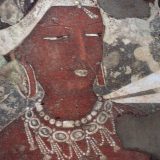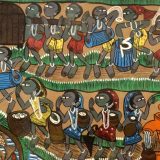The Ink Diaries

The desire to communicate messages, ideas and stories through the means of visual depiction is a phenomenon, filled with the aroma of antiqueness. One can perhaps suggest that the role of ink became pivotal the very moment there were ‘writings’ on the walls. Our prehistoric family, living near the Mesolithic rocks of Bhimbetka, used geru (iron oxide) to form red, limestone to paint in white and chalcedony to be used as green. As they held twig-handles of brushes made of animal furs or semal (silk-cotton) and dipped them in the colours that they formed, they painted huge animals, realistic pots, stick-figures and abstractions, vivid and beautiful, on the rocks which became their canvas. These colours were the first type of ‘inks’, used to deliver messages, many of which still remain an enigma for us. However, with time, the platform on which messages were to be permanently documented, were changed– we had to evolve from writing on rocks and caves to being able to make this means of communication both lighter as well as transportable, so that it could be used to keep records. And to write on these new materials, ink, as we know it today, had to be invented.

During the Bronze Age, the civilisations of Mesopotamia, Indus and Egypt had curated their own forms of writing. The scribes of Mesopotamia had mastered the use of stylus to be pressed into a wet clay tablet to produce wedge-shaped symbols. The stylus was crafted with a cut reed. With time, their system of writing ‘Cuneiform’ evolved to become complex and ‘phonetic-sized’. In the realms of the Indus, depictions of animals and written symbols found themselves printed on seals made of steatite, tokens, ‘boards’ etc. Unfortunately, scholars have failed to decipher the Indus script and thus, the Harappans have remained silenced. Turning our attention to the Ancient Egyptian lands, we find logographic, syllabic and alphabetic elements fused together to form their formal writing system, that of Hieroglyphs.

The earliest form of paper was made from the fibers of ‘papyrus’, which grew in the wilds of the Egyptian Delta. Papyrus is a marsh plant that grows straight reeds with hollow stems. The Egyptians cut these plants into thin strips and the reeds were beaten & pressed together and left to dry. The natural sap which was produced allowed for a smooth adherence of fibers to each other. This finally resulted in dry papyrus sheets. To write on papyrus, the Egyptians used a semi-fluid which was capable of being used on it. Thus, as early as the 2600 BC, the Egyptians began to use black ink, which was a thick mixture of lampblack and glue. The pigments were made from carbon collected from burning oil lamps, in which tar was burnt with vegetable oil. This carbon was mixed in gum to ensure its adherence on the surface. Once mixed, it was sun dried in the shape of sticks. Then, they would dip these sticks into water and ready them to be used on papyrus for writing.
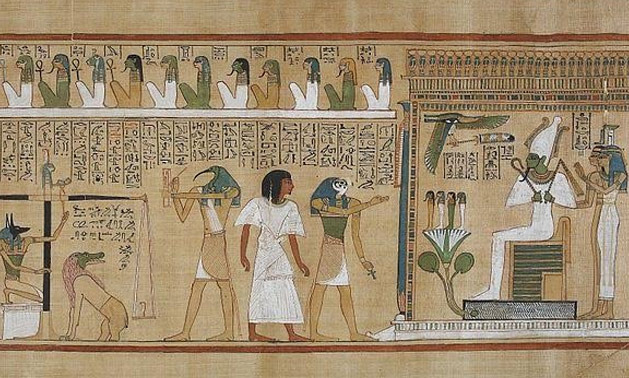
Before the Egyptian scribes began to write on these scrolls, they perfected the art on materials like stones and pieces of wood. After the craft had been mastered, the scribe was allowed to experience writing hymns, spiritual and religious texts, poems of love and works of literature. The manner in which the ink colours were used was crucial too – red ink, which was possibly derived from the earth pigment iron oxide, marked the beginning of a new paragraph and rubrics such as titles. The black ink was mostly used for writing the hieroglyphic letters. In a case, cakes of black and red paint would be kept and the scribe would use water to dilute the paint into ink. Thereafter, using his reed brushes, held in wooden or ivory pallets, he would give life to stories, legends, poetry, medical advice etc. To add a pinch of humor to the mundaneness of everyday life, scribes would draw satirical scenes on rocks and limestone, there would be depictions of animals playing humanistic roles such as the priest-cat and the mouse-disciple.

Dark pigments of dye such as black and blue-green which symbolised life, birth, the heavens and fertility, were also used for tattooing bodies in Ancient Egypt. In Ancient Egypt, the word ‘wꜣḏ’ signified the colour blue-green and was held by the Egyptians with high regard. The Egyptian blue was a pigment made up of a mixture of silica, lime, copper and an alkali. The tattoo artist of Egypt possibly made use of a bronze needle to draw on the bodies of women. From small household deities to symbolic elements, a diverse range of artistic designs featured on the bodies of these ancient men and women. Perhaps, they got inked due to mystical beliefs, to gain protection, to signify their social status or simply because they loved the idea of tattoos beautifying their bodies.
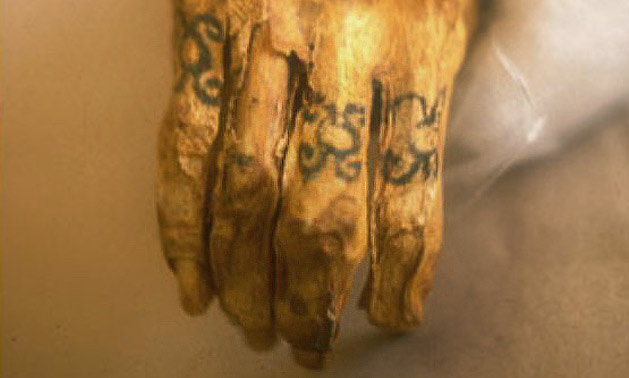
In around 1300 BC, the ‘royal purple’ dye began to be manufactured in the Phoenician city of Tyre. This dye, known as Tyrian purple, is said to have been a discovery of the pet dog of Tyros, the mistress of the Canaanite god, Melqart. Once upon a time, Melqart and Tyros were walking along the beach when their dog bit a mollusk, following this, his mouth was stained purple. In awe of the colour, Tyros ordered for a garment in imperial purple and thus began Tyre’s renowned dyeing industry. This dye and its textiles gained much popularity in the ancient world and were exported throughout the Mediterranean. Canaanites began to be referred to as ‘Phoenicians’ (purple people), the folks whose purple dye, extracted from murex shellfish, was worth more than its weight in gold. Though there were many shades of the dye, the most prized shade was black-tinted clotted blood.
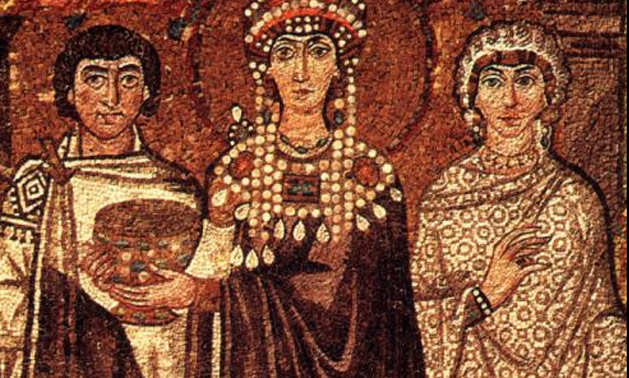
Tyrian purple evolved into a status symbol since it was extremely tough to manufacture. Imagine, each fish gland yielded around 1-2 drops of the purple ink and 60,000 fish would have their lives put at stake for a 450 ml bottle of ink. Therefore, Tyrian purple became one of the most expensive items of trade at the time, it was a form of ink which was made to dye wool purple. One of the finest qualities of this colour was that instead of fading over time, it would improve and look more radiant. By 300AD, the sumptuary laws of Rome had become so strict that only the Emperor could adorn Tyrian purple!
Around the time when paper was invented by Ts’ai Lun (100– 300 AD) or three centuries earlier when the hair-writing brush came into existence because of Meng T’ien, Chinese ink was in trade. The ink-makers of China would begin by grinding a mixture of hide glue, carbon black, lampblack and bone black pigment, this would be followed with them mixing it with pestle and mortar. This mixture was poured into a ceramic dish and left to dry – and once dried, they had in their hands, the glossy and dark pigment, used across the world: China, Korea, India and even parts of South-East Asia. This ink is also known as ‘Indian ink’. In Chinese political history, ink seems to have played a very defining role. The story goes back to the time when the Chinese dictator, Qin Shin Huang, was obsessed with the idea of attaining immortality. In his quest to become powerful, he conquered all of the warring states of China and created a unified nation – a diverse unified nation. The territory was so expansive and diverse, how was he to manage it all? Thus, he formed a plan. An order was established that each area that came under his control had to start writing with a standardised script. Thus, a common script, written with ink, became the formal script for the whole of China during the Qin dynasty – making words written with ink a crucial factor for unification. The successors of those calligraphers who worked on writing the script, went on to master the technique of ‘mo-shui’ (painting with ink and gouache to attain black shades) and with the help of this black pigment, they began to draw alluring landscapes, nature-scenes and mountains.

In Ancient India, ink was called ‘Mas’ or ‘Masi’. The scribes of Ancient India mainly used palm leaf; “Taal pat” as a material to document significant information on. People would collect leaves from the Talipot palm or Palmyra palm. After this, they would carefully cut the leaves and pierce them in three places (left, middle and right top) – a string was woven through these holes and one end of it was tied to a small object. After this platform was prepared, the scribe would begin engraving letters on this surface with a metal stylus (pointed pen-like object) and finally, once the message had been engraved, he would proceed to smear black soot mixed with vegetable oil on the leaf. This would fill up the engraved etchings and make the letters visible as black on the place Taal pat background. There were mainly two types of inks employed in ancient writing; edible and inedible ink. The scribes used the former for day-to-day purposes while the latter was used to write manuscripts. The most ordinary form of ink was prepared by mixing powdered charcoal, with gum and a sticky substance (such as sugar), dissolved in water, which would finally determine the colour of the ink. There were a variety of sources through which ink could be made; lamp-black, borax, gum, sugar, dust, charcoal etc. The carbon black India ink was obtained indigenously by burning bones, tar, pitch, and other substances.
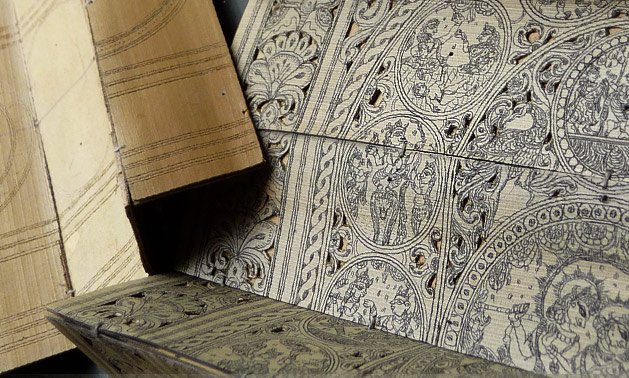
After the ink had been prepared, the stylus was in hand, the scribe was ready, these manuscripts became the canvas to document folk literature, religious messages, astrological and astronomical facts, medicinal knowledge, traditional practices, agricultural and craft skills etc. This style of creating manuscripts is still alive in India in the form of the beautiful craft of Talapatachitra of Orissa. Where artisans make mythological storyboards on strips of dried and stringed leaves even today. Within Buddhist and Jain traditions, writing ideas on manuscripts played an important role. The scribe of Jain manuscripts derived the ink-colours from natural sources and the prominent colour to write with was black, however, red too was used for ornamentation or to emphasize on a particular idea. If there was ever a mistake, the scribe would carefully apply yellow (Harda) or white (lime paste)pigments which would act as erasers.
Documenting ideas in written-form was also important for the Ancient European scriptoriums of 300AD, where scribes would dedicatedly for hours using their inks, silently make copies of religious texts, philosophical ideas, ‘pagan’ works and classical literature. This period proved to be revolutionary in the domain of writing & books since the ‘codex’ format from which modern-day books derive, began to be used during this time. The chief writing material that the scribes would use was made from the skins of animals – cows, sheep, goats, deer and the finest parchment was made of calfskin and was called vellum. The quill pen, which was made of a molted flight feather, was compatible with this parchment. There were times when the ink was too thin and the parchment was not the best. Understandably, to express his frustration in a silent library, the scribe would scribble away in the margins of his manuscript: “Thin ink, bad parchment, difficult text!” (Greenblatt 2011, 40).
It was between the 500AD and the 800AD that Greek and Latin texts with ‘pagan’ ideas began to be discarded and ceased to be written at all. These ideas were threatening to the Christian world and therefore had to be censored. With the use of knives, brushes and rags, the Christian monks would wash away these old works written in ink. They would take these parchment sheets, sit in the scriptoriums and replace old texts with new ideas which captured the essence of dominating and accepted norms. But who possesses the power to entirely erase the past? If the ink with which the original texts were written, proved to be firm then one could still read between the lines and decipher the language of the ‘censored’ texts. Thus, many gems of ancient ‘pagan’ wisdom – which were to be censored and hidden away from the rest of the world – have managed to survive, all because of the original ink.

As the Middle Ages made their cameo, the iron gall ink (common ink) gained massive popularity. This purple-black or brown-black ink marked a transition from the carbon-based inks which had been famous thus far. Made primarily out of galls, vitriol, gum and water – one of the defining features of this ink was that it could not easily be erased. The oldest and the most complete Bible currently known to exist, Codex Sinaiticus, was written with the help of this very ink. When vibrancy flourished in the domain of academia, art & culture during the medieval Renaissance, iron gall ink became an artistic tool, used for paintings and portrayals. One of the creative geniuses of this period, the Italian polymath, Leonardo da Vinci, used the iron-gall ink to draw realistic scenes. Even the iconic Mathematician, Sir Isaac Newton, was in awe of the qualities of this dark ink, so much so, that he used to make it at his own residence and has also left a recipe for the same, entitled: ‘To make excellent ink’. Newton would collect galls from oak trees and soak them in beer or ale along with Gum Arabic, for about a month. This process would lead to the production of Tannic acid which Newtown would mix with a green-blue chemical called copperas, finally resulting in a perfect brown-black solution that he would use as ink to note down many of his mathematical and scientific ideas on manuscripts, some of which still survive.
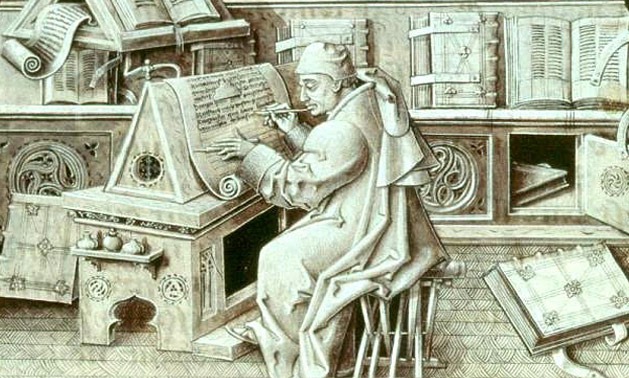
Thus, the iron-gall ink was used to pen down many paintings, philosophies and policies. Magic charms for healing toothaches, recovering lost voices and establishing a connection with spirits, written with this ink, have mystically survived in a Medieval manuscript: ‘Book of Magical Charms’. Fascination towards iron-gall ink remained strong and its legacy was untouched, till about the time chemically-produced inks and writing fluids with waterproof formulas which were better suited for writing on paper came in vogue. One of the other reasons why this ink was no longer prominently favourable was because of its acidic nature. Many times, the ink begins to ‘eat itself’ i.e. corrode and cause the parchment it is used on, to disintegrate.
It was Johann Gutenberg who invented Western printing. Following that invention, a Printing Press revolution took place in the 15th century AD. Because printing-technology had evolved, ink too had to adapt and thus new oily ink, made of soot and turpentine oil was created – to serve the purpose of the printing press. The inks of Gutenberg were made out of linseed oil, walnut oil, rosin, pitch, lamp-black and vermillion. When raw linseed-oil was clarified by heating in the 16th century AD, inks with a refiner quality began to be produced. Along with evolution in the realm of inks, development in the domain of pens was inevitable – in the 17th century AD, Daniel Schwenter created a pen from two quills that held the ink inside instead of being dipped, time and time again, into the inkwell. Much later, fountain pens came into existence and gained popularity because of the neat work they produced without being dipped into the inkwell.
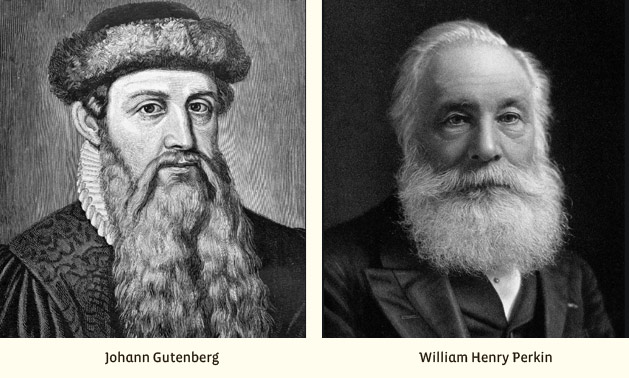
In the beginning of 1800 AD, the demand for print had exceeded to a point that for the printer, making ink became a herculean task. This encouraged independent ink-makers to flourish, who further experimented in this domain and gave birth to chemical-based coloured inks. In the 1800s, when William Henry Perkin was trying to find a cure for malaria, he discovered synthetic dyes which could be applied to ink – this discovery became commercially relevant for dyeing ink. And by the end of the same century, German chemists Schlutigg and Neumann, established a formula which they believed to be the best recipe for iron gall ink. In the 1900 AD, this German recipe was accepted by the state of Massachusetts as the ‘standard ink’ for all official documents. As of today, iron gall ink is mostly used by those who use fountain pens or artists. Body modification through inking oneself still remains a prominent art form and is used for decorative and symbolic purposes. Technological-revolution and the introduction of home printing made buying ink in the form of cartridges extremely common.
Evolution of ink therefore is the story of human dexterity in time; from being used on bodies to manuscripts, from beautifying portraits to aiding the advent of various writing tools with which we satiated our eternal need to express. With matter burnt down to fuel among other things; human imagination, we became the scribes of our own destiny. The scrolls passed from underneath our hands, changing forms forever… stones, clay tablets, skins, papyrus, cloth, paper to digital tablets. The ink now merely becomes an arrangement of pixels on a digital screen, playing with the cone cells of our own retina… enabling our eyes to see black alphabet distinct from its white background or vice versa. Dexterity comes full circle. Re-establishing the old saying that the whole industry of human existence; which is the world in its multiple manifestations outwardly, can be found within the most superior industry ever manifested; the body itself!
Sources:
Stephen Greenblatt, The Swerve: How the Renaissance Began
Upinder Singh, A History of Ancient and Early Medieval India: From the Stone Age to the 12th Century
Pines, Charles C. “The Story of Ink.” The American Journal of Police Science, vol. 2, no. 4, 1931, pp. 290–301
https://www.ancient.eu/image/10664/ancient-egyptian-ink-drawing-of-a-cat–mouse/
.https://www.ancient.eu/Egyptian_Papyrus/
https://www.domestika.org/en/blog/4091-the-history-of-india-ink-from-drunk-poets-to-sumi-https://www.historytoday.com/history-matters/history-ink-six-objects
https://irongallink.org/igi_index608d.html
https://elementsunearthed.com/tag/iron-gall-ink/
https://www.mixerdirect.com
http://www.historyofpencils.com/writing-instruments-history/history-of-ink-and-pen/
https://visual.ly/community/Infographics/history/history-ink
https://www.ancient.eu/article/1000/tattoos-in-ancient-egypt
https://en.wikipedia.org/wiki/Egyptian_blue
https://isabellasancientegypt.weebly.com/tools-and-media.html

